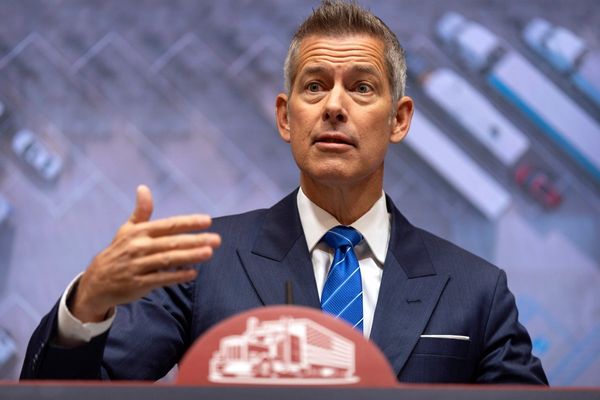
China has been pumping out some pretty sweet EVs lately. They're cheap, packed with boatloads of tech, and are arguably a pretty amazing value proposition for the money. It's kind of obvious why U.S. automakers are worried about the thought of these cars ever hitting the U.S. market.
Welcome back to Critical Materials, your daily roundup for all things electric and tech in the automotive space. Today, U.S. auto execs foresee Chinese EVs eventually hitting U.S. streets, China's version of cash-for-clunkers tops 10 million trade-ins for NEVs, and Tesla Employees call for CEO Elon Musk's resignation. Let's jump in.
30%: U.S. Automakers Agree: Chinese Cars Will Enter U.S. Market

It turns out the suits in Detroit aren't sweating whether or not Chinese EVs will make it to U.S. soil. Despite the attempts to implement protectionist measures (like tariffs) to keep China's biggest automakers at bay, the vast majority have just accepted Chinese cars as an inevitable competitor on their home turf.
The notion comes straight from Kerrigan Advisors' 2025 OEM Survey, a study that polls some of the top talent in automotive executive leadership on industry trends. According to respondents, a whopping 76% of automakers believe that Chinese carmakers will eventually begin selling vehicles in America. And perhaps equally as concerning, at least for legacy automakers, is that 70% say they're concerned about the financial implications it will bring.
Let's be clear, this isn't just some random paranoia that a bully is coming to take your lunch money. Chinese brands like BYD and Geely are already muscling their way into global markets like Europe and Latin America. They're using ruthless tactics like low costs, solid tech, and extremely fast production cycles to quickly penetrate the local market share.
This is just the start of a shifting industry. The survey also suggests that the way automakers sell cars will change.
That doesn't mean legacy automakers will get out of the dealer sales model they're stuck in. Instead, OEMs are looking to shrink their dealer networks to have a few hundred large dealers to do business with, rather than a few thousand smaller ones. In fact, only 14% of respondents said that they anticipated their dealer networks to grow.
Here's a great synopsis of the theory from Automotive News:
Another new question on this year’s survey found a third of automaker executives expect to have fewer dealers in their network in the next five years; just 14 percent expect to have more. And in another new question, 28 percent said they will exercise a right of first refusal—a tool that allows an automaker to refuse a potential store buyer and replace them with a buyer of their choice—more than a quarter of the time in the buy-sell deals they receive.
“It’s certainly consistent with what we have observed in the buy-sell market and in our conversations with OEMs where certain OEMs are vocally saying ‘We want fewer, larger dealers,’” Kerrigan said. “As we see it, the OEMs are retreating from the idea that they will be the direct-to-consumer seller.”
When China's finely-tuned industrial machine finally does land here at home, Detroit will be in for a wake-up call. There's a reason these brands spend so much time doing reverse engineering on cars coming out of Guangdong—China is very good at this whole "make-a-car" thing. And if their automakers can do it better than U.S. companies at a fraction of the cost, legacy brands are in trouble.
60%: China's Version Of Cash-For-Clunkers Gets 10 Million Trade-Ins

Back in 2009, the U.S. had this crazy scheme to stimulate the economy while also simultaneously lowering emissions around the country. Cash For Clunkers was a brazen way of offering Americans a boat load of cash on the hood of just about any new car, so as long as the vehicle they traded-in towards it sucked down fuel more quickly. The program bled through its entire funding in just two months. The total number of cars crushed for the program? 677,081.
Last May, China decided to try its own take on that model and basically supersized America's success. According to Car News China, its year-long program had a whopping 10 million crusty combustion cars traded in for shiny, state-of-the-art New Energy Vehicles (NEVs).
Here are the facts from Car News China:
According to recent figures from the Ministry of Commerce, China’s vehicle trade-in scheme has received more than 10 million applications since the policy began in 2024. As of May 11, 2025, 3.225 million applications were submitted this year, including 1.035 million for scrapping older vehicles and 2.19 million for trade-in replacements.
The policy has had a notable impact on vehicle purchasing behaviour. Data from the China Passenger Car Association (CPCA) shows that in April, nearly 70% of private car buyers utilized the trade-in scheme, while first-time buyers accounted for just 31%, suggesting a shift in demand toward vehicle upgrades.
[...]
Two major trends are currently shaping the automotive sector. First, consumer interest in green and smart vehicles is increasing. New energy vehicles (NEVs) accounted for over 53% of all trade-in transactions. NEV sales totalled 3.324 million units from January to April, up 35.7% year-on-year. Market penetration for NEVs reached 48.4%, a 0.8 percentage point increase from 2024.
Second, the recycling activity has expanded significantly. Between January and April this year, 2.767 million scrapped vehicles were processed for recycling, representing a 65% year-on-year increase. This reflects greater attention among consumers to environmental issues and resource reuse.
China's goal was pretty much the same as America's program. It helped reduce vehicle emissions while simultaneously boosting domestic auto production of BEVs and hybrids, something that China is propping up as its automakers prepare for world automotive domination. As the numbers alone can probably tell you, the plan is working.
This is also kind of a big flex against America, which is pretty audibly fighting over whether or not to keep the EV tax credit alive. Stateside automakers have backed off of otherwise ambitious EV goals when consumers weren't biting, while China doubled down to support domestic manufacturing and growth. If auto executives are worried about China's EV dominance, perhaps the success of this program shows that the real fight should be lobbying in Washington to advocate for more effective support.
90%: Tesla Employee Fired After Calling For Elon Musk's Resignation

At Tesla, the concept of being open to feedback seems to stop somewhere between "there's a safety problem with the Model S" and "Elon should resign." Recently, one employee tested that line when he published an open letter to the CEO calling for his resignation due to the seeping of Musk's personal brand onto that of Tesla's.
Meet Matthew LaBrot. He's a Tesla employee who drives a Cybertruck, owns a Model Y, has Tesla Solar, and believes in the company's mission—albeit without Elon Musk at the helm. LaBrot found himself growing increasingly frustrated with Musk over the past few months (a sentiment similar to many would-be Tesla buyers who chose to avoid the brand due to Musk's political involvement).
The employee went on to publish a website called Tesla Employees Against Elon that called out the CEO's recent behavior as grounds for him to resign and let someone else take over the automaker. That public call-out quickly got him fired.
Here's an excerpt from the site:
The damage done to Elon’s personal brand is now irreversible and as the public face of Tesla, that damage has become our burden. We are now at a crossroads: continue with Elon as CEO and face further decline as customers abandon the brand, or move forward without him and allow our products and mission to succeed or fail on their own.
We vote for the latter. It’s time to say the quiet part out loud.
Elon’s recent claim that he is “refocusing” on Tesla is not only tone-deaf, it’s insulting. It implies that the hardships of the past six months stem from a lack of his attention, not from his actions. It shifts the blame onto the very people who have held this company together. Let’s be clear: we are not the problem. Our products are not the problem. Our engineering, service, and delivery teams are not the problem. The problem is demand. The problem is Elon.
[...]
Now those very cars are sitting unsold, growing week after week. Production is running better than ever. Quality is high. Processes are strong. Demand is what’s broken. This is not a product problem. It is a leadership problem.
We want to be clear: none of this erases the impact Elon has had on Tesla’s journey. He helped create something extraordinary. The mission we’re fighting for exists in large part because of his early vision. But that doesn’t mean he’s the right person to lead us forward now. In fact, it’s clear he’s not.
After publishing the site (which is signed as if it were penned by multiple employees), LaBrot attended a protest at a Tesla facility. He spray-painted his personal Cybertruck with his website and the slogan "pro clean energy, pro sustainability, pro EV, pro Tesla, anti Elon" and parked it outside the Tesla facility where the protest was held. The next day, he got a call from Tesla's HR that his employment at his "dream job" was terminated. His account on X—owned by the self-proclaimed "free speech absolutist" CEO—was also suspended.
Now, it wasn't actually publishing the website that got LaBrot fired. According to Business Insider, LaBrot was told that the reason he was let go was because he used "company resources to build a website that did not align with the company's perspective." LaBrot denied using Tesla resources to build the site in an interview with Business Insider.
The claims made on LaBrot's site aren't exactly hot takes. They're lukewarm at best, and Tesla is well aware of the public perception of its CEO since he began his involvement in U.S. politics. In fact, Tesla even acknowledged that "changing political sentiment" was affecting demand for its vehicles in some markets.
It's not difficult to connect the dots here, and LaBrot's firing highlights Musk's zero tolerance for dissent. In this case, an employee disagreed with the guy at the top of the company, publicly aired grievances, and experienced a professionally lethal blow to his career. It seems that if the CEO has carved his public image into stone and the board won't take measures into its own hands to improve sales, then it's going to be up to the public to determine Tesla's future. Judging by the recent drop in vehicle demand, public opinion has already issued a verdict.
100%: Are You Excited For Chinese EVs?

The other day, the crew here at IEVs was having a conversation about Chinese EVs. And after hearing all about Patrick's George's time in China, it finally struck me: those China-market-only models were a mistake. The entire world should be getting these cars.
Personally, if you offered me a Xiaomi SU7 Ultra for the price that the home market is paying, I'd buy it in a heartbeat. Name another car with the style, features, and 1,548 all-electric horsepower you can nab for under $75,000 brand new.
The fact that auto executives are forecasting Chinese EVs hitting the U.S. means we're about to get some serious competition. If America wants to stay ahead, then our automakers need to become pioneers again. You know what they say, "innovate or die."
So, finally, we come to the big question: are you excited for Chinese EVs to make it to the U.S.? Let me know why (or why not) in the comments.







